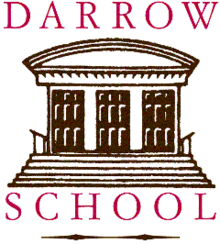Darrow School
Coordinates: 42°27′10.94″N 73°22′58.49″W / 42.4530389°N 73.3829139°W
| Darrow School | |
|---|---|
 | |
| Address | |
|
110 Darrow Road New Lebanon,, New York, Columbia County 12125 United States | |
| Information | |
| School type | Independent, Boarding & Day |
| Denomination | Non-denominational |
| Founded | 1932 |
| Oversight | Board of Trustees |
| Chairperson | Robert W. Kee '71 |
| Head of school | Simon Holzapfel |
| Staff | 52 |
| Teaching staff | 31 |
| Grades | 9-12 |
| Gender | coed |
| Enrollment | 100 |
| Average class size | 8-9 |
| Student to teacher ratio | 4:1 |
| Language | English |
| Campus size | 365 acres (1.48 km2) |
| Houses | Ann Lee, Brethren's, Hinckley, Neale, Meacham |
| School color(s) |
Maroon and white
|
| Song | "Simple Gifts" |
| Athletics | Basketball, Cross-Country, Lacrosse, Soccer, Softball, Tennis, Ultimate Frisbee, Outdoor Education, Alpine Skiing, Fitness |
| Athletics conference | HVAL, NEPSAC |
| Mascot | Darrow Ducks |
| Accreditation | MSACS |
| Publication | The Peg Board |
| Endowment | $3 million |
| Affiliation | NAIS, TABS, NYSAIS, NYBSA |
| Website |
www |
Darrow School is an independent, co-educational college-preparatory school for boarding and day students in grades 9-12. Its New Lebanon campus is a 365-acre (1.48 km2) property just to the west of the boundary between New York and Massachusetts in the Taconic Mountains and within the Berkshire cultural region.
History
The school's campus is located at the site of the largest and most industrious Shaker community in the country.[1] Darrow opened in the fall of 1932 as the Lebanon School for Boys. It was renamed "Darrow School" in 1939 in honor of the Darrow family, who settled the land and provided support and leadership in the early years of the Shaker community. In the later part of the 20th century it began to accept female students.
More than a decade before the last of the Shakers left in 1947, they set in motion plans for a school. In 1931 New Lebanon admiralty lawyer Charles Haight was contacted to make their idea a reality. In 1932, the school opened its doors, repurposing many of the original Shaker buildings as classrooms, meeting, dining, and athletic facilities, and dormitories for both students and teachers. Darrow School’s buildings have been well maintained throughout the school’s 83-year history, and although some accommodations have been made for modern living and learning, all renovations have been conducted in consideration of the Shaker principles of simplicity, function, beauty, and stewardship of both the historic site and the earth.
In the late 1980s the school was forced to sell much of its original Shaker furniture to meet budget deficits, and the board of trustees voted to close the school at the end of the school's spring 1991 term. The board reversed their decision after parents, current students, and alumni of the school fundraised over $250,000.
The school currently enrolls about 100 students and employs 31 teachers. Students come primarily from New York and Massachusetts, however, the school has a sizable population from other states as well as countries such as Japan, Jamaica, Turkey, China, and Ghana.
The National Association of Independent Schools (NAIS) has recognized Darrow School as a Leading Edge Honoree for its curriculum innovation, specifically in the area of sustainability. The School’s Sustainability Program is an important feature of the academic program and examines the relationship between people and their resources.
Location
Darrow School is located on Mount Lebanon in the Taconic Mountains, just to the west of the central Berkshires, in New Lebanon, New York. Darrow Road, marked by Darrow School’s sign, turns off of Route 20 seven miles (11 km) west of Pittsfield, Massachusetts and 26 miles (42 km) east of Albany, New York. Darrow is approximately 150 miles (240 km) north of New York City and 150 miles (240 km) west of Boston.
Darrow occupies the 365-acre (1.48 km2) site and buildings of an original Shaker village that has been designated a National Historic Landmark. Darrow has 26 buildings, 4 playing fields, 2 tennis courts, 5 residential dormitories, a 15,000 volume library, a 12,000-square-foot (1,100 m2) arts center, and a three building science facility that includes a Living Machine (natural wastewater treatment and learning center).
Notable alumni
- Charles "Pete" Conrad, Jr., Apollo 12 commander and third man to walk on the moon. Darrow Class of 1949.
- Chris "Mad Dog" Russo, sportscaster and radio personality. Darrow Class of 1979.
- Sam Harper, screenwriter of Cheaper by the Dozen and Cheaper by the Dozen 2. Darrow Class of 1979.
- Christopher Lloyd, actor who appeared in Taxi and Back to the Future.
- William H. Hudnut III, mayor of Indianapolis
References
- ↑ "Shaker Historic Trail, Mount Lebanon Shaker Society". National Park Service. Retrieved 2012-12-14.